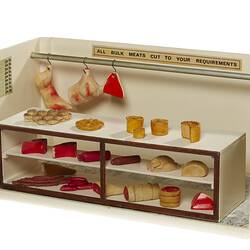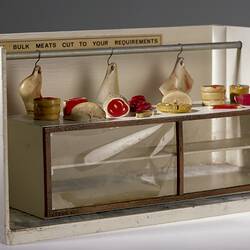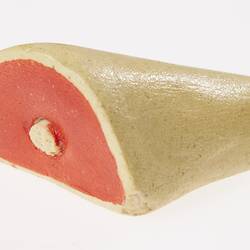Summary
Model butcher's shop interior with three-level bench displaying plaster model of meat cuts, pies, sausages and rissoles.
The model shop was acquired from the St Vincent De Paul Society in Port Melbourne in 2002, without further provenance. R.E. Williamson is identified as the 'Master Butcher' on the outer wall of the shop, but this shop does not appear in the Sands & McDougall directory, nor in newspapers accessed via Trove. This suggests that the model is either based on an interstate butcher or purely fictitious.
A scale model toy butcher's shop - 'something unusual... complete with all accessories' - was advertised in The West Australian, 3 May 1947, p. 8. However, the decimal currency and imperial weights on HT 731's labelling suggests it dates no earlier than 1966 (when decimal currency was introduced) and no later than 1974 (when metric measurements were introduced) - or at least the labelling on the model is from that date range.
Physical Description
Model of the interior of a butcher's shop with open front and three sides. On the outside of two sides is notional signage. On the interior walls is signage listing different cuts of meat and the price in decimal currency per lb. A freestanding shop counter sits across the width of the shop. Its top provides a surface for conducting transactions. Underneath provides glass fronted storage for cuts of meat. Also includes 35 painted plaster models of cuts of meat and three metal hooks from which the carcasses can be suspended on a rod across the rear of the shop.
Significance
Significance:
The model provides a fascinating look at how the retail butchering trade was conducted before the impact of new display refrigeration technology resulted in a shift ultimately towards open-display and some pre-sale packaging. Efforts to identify RE Williamson, Master Butcher in the Sands & McDougall directories for the relevant years have been unsuccessful. This suggests the model is either based on an interstate butcher or purely fictitious.
The model evokes the essential form of the butcher shop that held sway for most of the central decades of the 20th century. The date of the model is suggested by the use of decimal currency and Imperial weights in its signage, therefore placing it between 1966 and 1974. This indicates the model was made just when butchers were beginning to install window-side open-refrigeration that tended to offer a wide range of meats, many of them pre-cut and pre-packaged. The lead for these changes came largely from supermarkets where the consumer could pick and choose without any direct contact with a butcher.
The model is suggestive of ealier work practices. Several meats would be 'to hand' within the glass-fronted counter. These meats would constitute only a fraction of the butcher's stock and would be rotated with others placed in a relatively large walk-in refrigerator to the rear. Incoming whole carcasses would hang on the rail behind the counter, awating dissection.
More Information
-
Collecting Areas
-
Acquisition Information
Donation from St Vincent De Paul Society, 21 Feb 2002
-
Date Made
circa 1966-1974
Based on use of imperial weights and decimal currency on model. -
Inscriptions
On back wall of model: 'ALL BULK MEATS CUT TO YOUR REQUIREMENTS'. Side walls of model: Lists of meat cuts and prices On outer walls of the model: 'R.E. WILLIAMSON LTD. / [3 stars] / MASTER BUTCHER'.
-
Classification
-
Category
-
Discipline
-
Type of item
-
References
Advertising (1947, May 3). The West Australian (Perth, WA : 1879 - 1954), p. 8 (SECOND EDITION.). Retrieved August 7, 2019, from [Link 1] 'Shops and Shopping', Miniature Living, no date or author (in supplementary file)
-
Keywords
Butchers' Shops, Decimal Currency, Imperial Weights, Meat, Model Food, Model Shops, Retailing, Shop Fit-Out, Working Life, Toys, Play
















